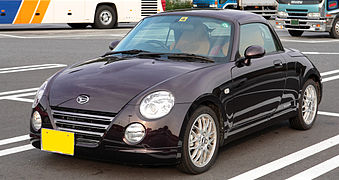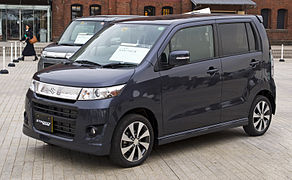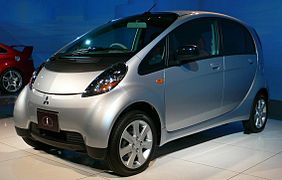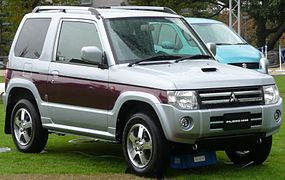Kei car
As Kei-Car ( Japanese. 軽 自動 車 , keijidōsha literally "light automobile", also K-Car ) small cars are referred to in Japan . Kei cars account for around a third of all new registrations in Japan. Since October 1998 they have been allowed to be a maximum of 3.39 meters long and 1.475 m wide, the engine may have a maximum displacement of 660 cm³. Privately registered Kei-Cars receive a yellow license plate with black letters, commercially registered vehicles a black license plate with yellow letters. With the approval as a kei car, a tax deduction and the exemption from proof of a parking space go hand in hand. Despite the small external dimensions, the Kei Cars are available in various body shapes such as small cars, microvans or off-road vehicles.
In Japan there is an unusually large variety of models in this design that are not common in other markets. The equipment also includes features that you would not expect in a small car. The Daihatsu Cuore , built in Japan under the name Mira , is also offered with all-wheel drive , distance radar, vehicle dynamics control (ESP), DVD navigation, xenon headlights and several airbags. In addition, turbocharged micro-engines have been developed that comply with the displacement restriction and still offer considerable performance. The Suzuki Twin was the first hybrid kei car from 2003 to 2005 .
The Kei cars Daihatsu Cuore , Copen and Suzuki Wagon R + , which were formerly also offered in Germany , do not have the typical 660 cm³ engine, but engines with a larger displacement.
In 2018, 40% of Japanese cars registered were kei cars. American automobile manufacturers do not manufacture kei cars just because of the current Japanese import conditions.
Generations of the norm
Over the years, the limit values for Kei-Cars were gradually increased until they got the typical dimensions of a small car in the format 1.48 by 3.4 meters.
| date | Maximum length (in m ) |
Maximum width (in m) |
Maximum height (in m) |
Maximum displacement (cm³) | Maximum Performance | |
|---|---|---|---|---|---|---|
| Four stroke | Two-stroke | |||||
| July 8, 1949 | 2.8 | 1 | 2 | 150 | 100 | no information |
| July 26, 1950 | 3 | 1.3 | 300 | 200 | ||
| August 16, 1951 | 360 | 240 | ||||
| April 4th 1955 | 360 | |||||
| January 1, 1976 | 3.2 | 1.4 | 550 | |||
| March 1990 | 3.3 | 660 | 64 PS (47 kW ) | |||
| October 1, 1998 | 3.4 | 1.48 | ||||
A source confirms 280 cm length, 100 cm width, 200 cm height, 150 cm³ displacement for four-stroke engines and 100 cm³ displacement for two-stroke engines as the first limit, but does not give a date.
gallery
Subaru 360 (1958)
Mazda R360 (1960)
Mitsubishi Minica (1962)
Honda N360 (1967)
Daihatsu Move -Custom
Honda Zest Spark
See also
Web links
Individual evidence
- ↑ Why Ford And Other American Cars Don't Sell In Japan , CNBC , April 16, 2019
- ↑ Jeremy Risdon: Pomchi Book of Cars, Vans & Light Trucks. Volume 3. Japan 1940-1949 . Pomchi Press, Yate 2018, ISBN 978-1-72004-729-2 , pp. 24 (English).


















